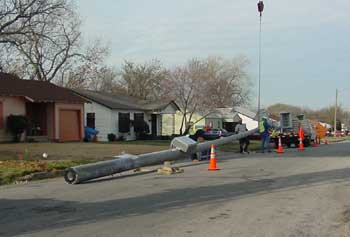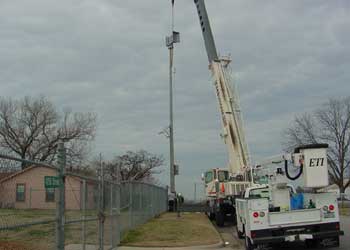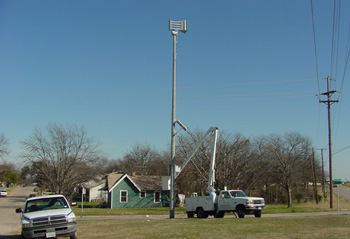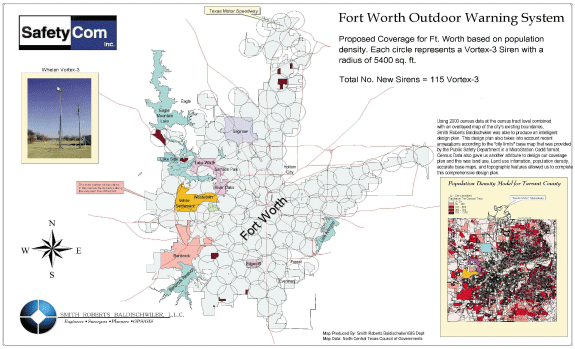|
THIS PROJECT IS CURRENTLY IN THE IMPLEMENTATION PHASE.
CHECK BACK THROUGH OUT THE COMING MONTHS AS THE PROJECT NEARS COMPLETION FOR UPDATES AND INFORMATION.
Over the past several years, Fort Worth Texas has been hit by pounding hailstorms, raging floodwaters and two, violent tornados. These storms caused millions of dollars in damage, numerous injuries and several deaths. While property damage is nearly impossible to prevent during violent weather, injuries and deaths are a different story. With ample warning, people can seek shelter and protect themselves.
In order to provide it’s residents with more time to take cover from severe weather, The City of Fort Worth entered into a contract with SafetyCom, Inc. in October, 2002 to replace the existing outdoor warning system with a new, technologically advanced system.
The Old System
Fort Worth currently uses a system of approximately 70 outdated electro-mechanical sirens located in or near the central city. Parts of the system are more than 30 years old. This system has become a maintenance nightmare, as failures become more and more prevalent and replacement parts have become difficult or impossible to find. Residents have complained that some of the sirens either fail to sound adequately or to sound at all during periodic tests and actual emergencies. Even if 100% of the sirens were operational in all tests and emergencies, some parts of the city would still not be adequately warned. As the city continues to grow, the existing system has become even less effective than it was thought to be.
The New System
In searching for new alternatives to the existing system, city officials requested proposals from leading firms in the outdoor warning system industry. A number of proposals were received from qualified firms, but the SafetyCom proposal offered distinct advantages over its competitors including quality of products, contractor and sub-contractor experience and implementation procedures. The SafetyCom system includes approximately 132 electronic sirens mounted on 50-foot concrete poles throughout the city. Each siren can be tested and controlled individually by a radio transmitter at a central location, and is powered by batteries recharged with solar energy. The components of this proposed system are described in the following paragraphs.
System Components

Sirens
The new sirens, can emit a 70-decibel warning signal in a 360-degree rotating path for up to 30 continuous minutes on fully charged batteries. Each siren assembly has been designed to withstand high winds, lightning strikes, and other adverse conditions typically experienced in severe weather.

Poles
In order to ensure adequate coverage of the area, the new system includes 132 concrete poles placed throughout the city. Each pole will stand approximately 50 feet high, with a siren assembly on top and a control box attached 10 feet above the ground. The poles are constructed using a centrifugal pouring process, which minimizes weak points in the concrete and results in structural resistance to winds exceeding 150 miles per hour.

Control Boxes
Control boxes for the siren assemblies will contain batteries, radio units, and other necessary electronics. These boxes will be attached to each pole a minimum of 10 feet from the ground to prevent tampering and damage. A connection from the box to the siren assembly at the top of the pole will be established through wiring concealed inside the pole. Each siren assembly is designed to respond to specific radio frequencies.
Power Source
Each siren assembly will be powered by batteries that are continually recharged with solar power. The sun’s energy will be collected with solar panels attached to each pole. Lexan, a Plexiglas-style material that shields the solar panels while allowing the sun’s rays to pass through, will protect all solar panels from hail strikes and other falling hazards.
Since many older outdoor siren-warning systems are powered with commercial alternating current (AC) connections, the proposed system is a departure from older systems. However, a solar-powered warning system offers several advantages over AC-powered systems:
– Installation requires no trenching or hanging of power lines
– Elimination of reliance on nearby AC power sources makes siren site selection faster and easier; optimal siren locations are often avoided in AC-powered systems because installation becomes cost-prohibitive
– AC-powered warning systems are vulnerable to extended power outages
– AC-charged batteries tend to have a shorter life span than solar-charged batteries
– Solar power is abundant, clean, and free AC-powered electrical meter are expensive to install, especially at low usage sites such as warning siren locations
– Warning sirens can be installed in remote or newly annexed areas that have few AC power sources readily available.
Central Control System
A control system, including a computer and radio transmission unit, will be installed in two central locations so that city employees can test and operate the outdoor siren warning system in conjunction with other emergency response activities. The console will be connected to radio transmission antennas located in sites agreed upon by City staff and representatives of the firm assisting with installation of the system. As with all emergency response systems, the new system includes plans for a backup operations site, control console, and transmission antenna. The redundancy of siren equipment and related control devices reduces the warning system’s vulnerability to a “single-point failure,” a situation in which an entire system could be disabled by the destruction of a single component.
The new system will cover all existing areas of Fort Worth. Each siren will cover an average of approximately three square miles, as represented by each of the circles on the map above.
The location of each siren will be based on the following criteria:
– Strength of radio signal received
– Consent of nearby residents, notified in advance with signs and fliers
– Relative location to other sirens
– Warning signal audible at acceptable distance
– Aesthetic considerations
– Other criteria as identified by citizens and City staff
Implementation Schedule
Contract finalized and signed October 2002
Site selection began in December 2002
Installation of Sirens began in February 2003
Installation of radio equipment is scheduled for Late-March 2003
Installation completion is currently on target for Early-Summer 2003
Acceptance testing is targeted for Mid-Summer 2003
System fully accepted and operational Late Summer 2003
Radio system installation was scheduled to be one of the first steps of installation. However, we have experienced many delays in this area. After the radio system is proven to be operational, new siren installation will begin in areas that currently have no operating sirens. Once the radio system is installed and operational the new sirens will be operational as soon as they are installed. The old sirens will be removed when new sirens are proven to be operational as part of the acceptance test.
Costs
The City has set aside $3 million in certificate of obligation (CO) funding for the purchase and installation of this system. However, City staff involved with the development of this project estimate that the system, as proposed, will cost slightly less than $3 million. Each additional siren assembly (beyond the initial 132 sirens) is estimated to cost $20,000, including installation. As the city grows, so will the system.
|




